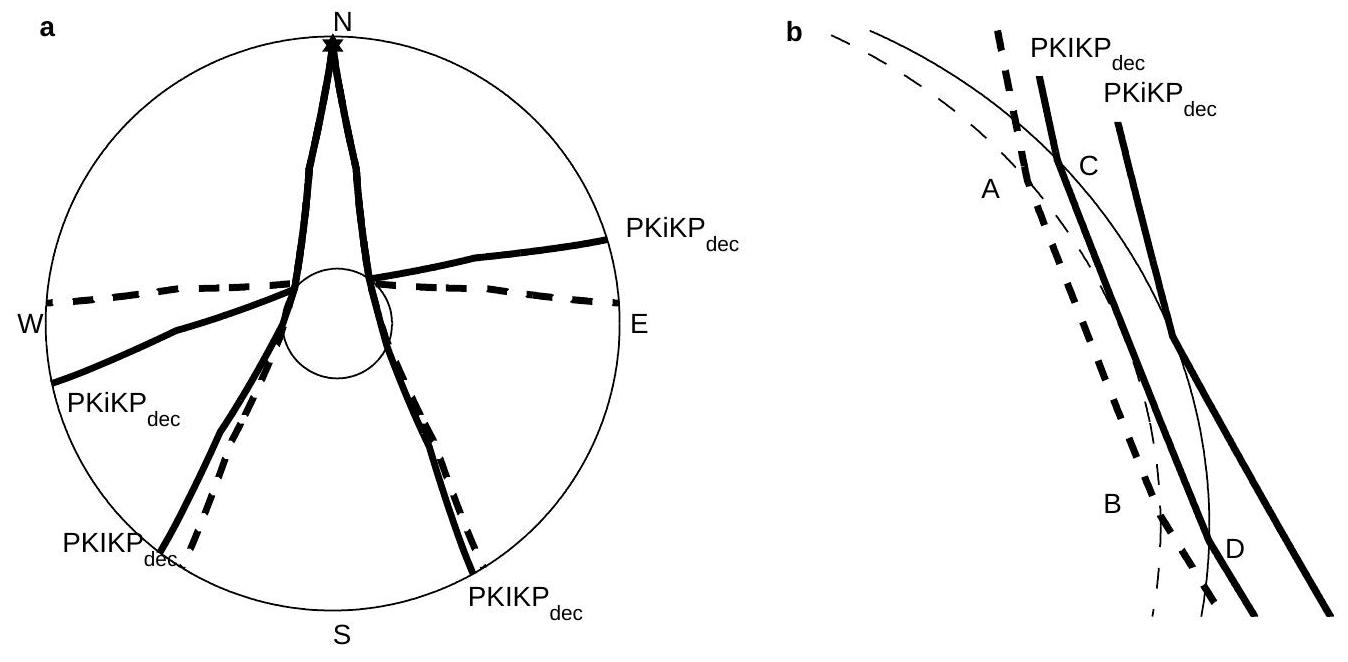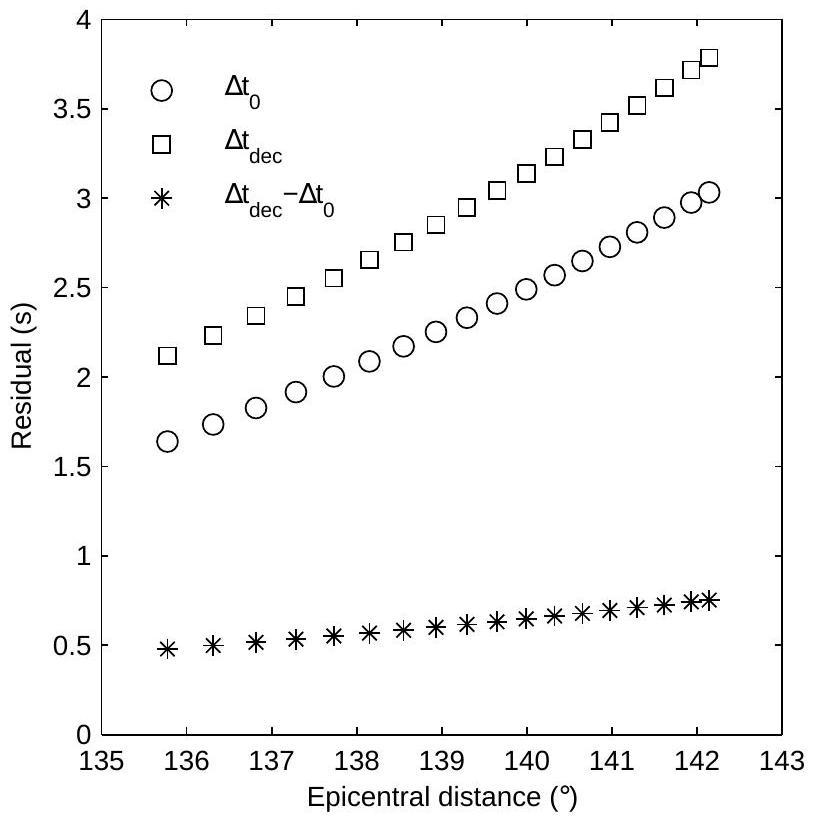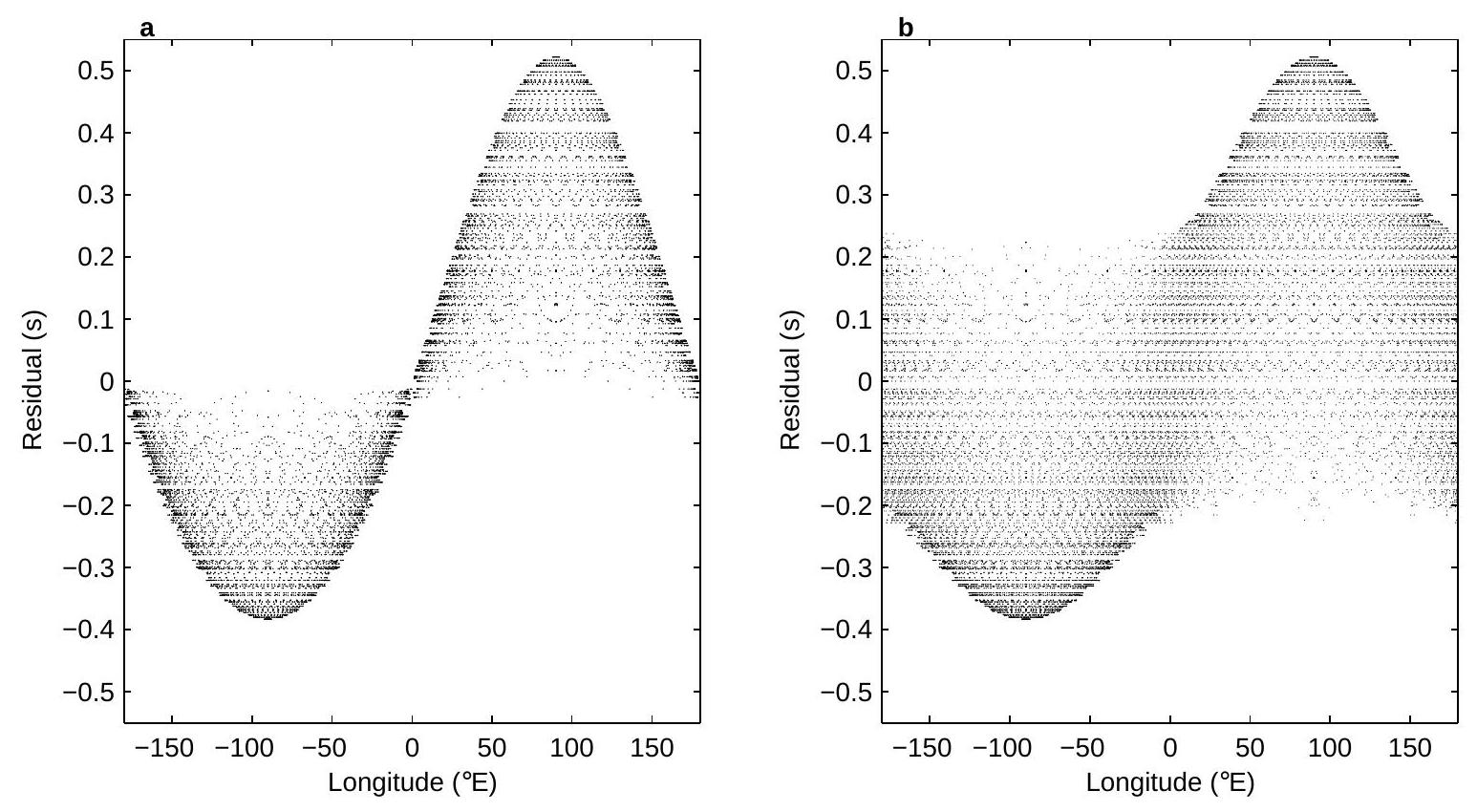Abstract
In a first approximation, the Earth’s interior has an isotropic structure with a spherical symmetry. Over the last decades the geophysical observations have revealed, at different spatial scales, the existence of several perturbations from this basic structure. Some of them are situated in the neighborhood of the inner core boundary (ICB).
One of the best documented perturbations is the asymmetry at the top of the inner core (ATIC) characterized by faster seismic wave velocity in the eastern hemisphere than in the western hemisphere.
All existing explanations are based on a hemispheric variation of the material properties near ICB inside the inner core.
Using numerical simulations of the seismic ray propagation, we show that the ATIC can be explained as well by the displacement of the inner core towards east in the equatorial plane tens of kilometers from the Earth’s center, without modifying the spherical symmetry in the upper inner core.
The hypothesis of a displaced inner core is also sustained by other observed hemispheric asymmetries at the top of the inner core and at the bottom of the outer core.
A displaced inner core would have major implications for many mechanical, thermal, and magnetic phenomena in the Earth’s interior.
Authors
Keywords
Cite this paper as:
C. Vamoş, N. Suciu, Seismic hemispheric asymmetry induced by Earth’s inner core decentering, arXiv:1111.1121v1, 2011
References
see the expansion block below.
About this paper
Journal
Publisher Name
DOI
Print ISSN
Online ISSN
MR
ZBL
[1] Poupinet, G., R. Pillet, A. Souriau (1983), Possible heterogeneity of the Earth’s core deduced from PKIKP travel times, Nature, 305, 204–206.
[2] Morelli, A., A. M. Dziewonski, and J. H. Woodhouse (1986), Anisotropy of the inner core inferred from PKIKP travel times, Geophys. Res. Lett., 13, 1545–1548.
[3] Garcia, R., and A. Souriau (2000), Inner core anisotropy and heterogeneity level, Geophys. Res. Lett., 27, 3121– 3124.
[4] Ouzounis, A., and K. Creager (2001), Isotropy overlying anisotropy at the top of the inner core, Geophys. Res. Lett., 28, 4331–4334.
[5] Niu, F., and L. Wen (2001), Hemispherical variations in seismic velocity at the top of the Earth’s inner core, Nature, 410, 1081–1084.
[6] Wen, L., and F. Niu (2002), Seismic velocity and attenuation structures in the top of the Earth’s inner core, J. Geophys. Res., 107 (B11), 2273.
[7] Sumita, I., and P. Olson (2002), Rotating thermal convection experiments in a hemispherical shell with heterogeneous boundary heat flux: implications for the Earth’s core, J. Geophys. Res., 107, 2169.
[8] Yu, W., L. Wen, and F. Niu (2005), Seismic velocity structure in the Earth’s outer core, J. Geophys. Res., 110, B02302.
[9] Yu, W., and L. Wen (2006), Seismic velocity and attenuation structures in the top 400 km of the Earth’s inner core along equatorial paths, J. Geophys. Res., 111, B07308.
[10] Souriau, A. (2007), Deep Earth Structure The Earths Cores, in Treatise on Geophysics, Vol. 1, Seismology and Structure of the Earth, edited by G. Schubert, B. Romanowicz, A. Dziewonski, pp. 655-693, Elsevier, Amsterdam.
[11] Aubert, J., H. Amit, G. Hulot, and P. Olson (2008), Thermochemical flows couple the Earth’s inner core growth to mantle heterogeneity, Nature, 454, 758–761.
[12] Sun, X., and X. Song (2008), The inner core of the Earth: Texturing of iron crystals from three-dimensional seismic anisotropy, Earth Planet. Sci. Lett., 269, 56–65.
[13] Monnereau, M., M. Calvet, L. Margerin, and A. Souriau (2010), Lopsided Growth of Earth’s Inner Core, Science, 328, 1014–1017.
[14] Deuss, A., J. C. E. Irving, and J. H. Woodhouse (2010), Regional variation of inner core anisotropy from seismic normal mode observations, Science, 328, 1018–1020.
[15] Rohrbach, A., and M. W. Schmidt (2011), Redox freezing and melting in the Earth’s deep mantle resulting from carbon-iron redox coupling, Nature, 472, 209–212.
[16] Waszek, L., J. Irving, and A. Deuss (2011), Reconciling the hemispherical structure of Earth’s inner core with its super-rotation, Nature Geoscience, 4, 264–267.
[17] Alboussiere, T., R. Deguen, and M. Melzani (2010), Melting-induced stratification above the Earth’s inner core due to convective translation, Nature, 466, 744–747.
[18] Won, I. J., and J. T. Kuo (1973), Oscillation of the Earth’s inner core and its relation to the generation of geomagnetic field, J. Geophys. Res., 78, 905–911.
[19] Buffett, B. A., and D. E. Goertz (1995), Magnetic damping of the translational oscillations of the inner core, Geophys. J. Int., 120, 103–110.
[20] Buffett, B. A., and J. Bloxham (2000), Deformation of Earth’s inner core by electromagnetic forces, Geophys. Res. Lett., 27, 4001–4004.
[21] Buffett, B. A., and G. A. Glatzmaier (2000), Gravitational braking of inner core rotation in geodynamo simulations, Geophys. Res. Lett., 27, 3125–3128.
[22] Buffett, B. A. (2010), Tidal dissipation and the strength of the Earth’s internal magnetic field, Nature, 468, 952– 954.
[23] Su, W., A. M. Dziewonski, and R. Jeanloz (1996), Planet within a planet: Rotation of the Inner Core of Earth, Science, 274, 1883–1887.
[24] Dumberry, D., and J. Mound (2010), Inner core-mantle gravitational locking and the super-rotation of the inner core, Geophys. J. Int., 181, 806–817.
[25] Kennett, B., E. Engdahl, and R. Buland (1995), Constraints on seismic velocities in the Earth from travel times, Geophys. J. Int., 122, 108–124.
[26] Li, X., and V. F. Cormier (2002), Frequency-dependent seismic attenuation in the inner core 1. A viscoelastic interpretation, J. Geophys. Res., 107, 2361.
[27] Cao, A., and B. Romanowicz (2004), Hemispherical transition of seismic attenuation at the top of the Earth’s inner core Earth Planet. Sci. Lett., 228, 243–253.
[28] Oreshin, S. I., and L. P. Vinnik (2004), Heterogeneity and anisotropy of seismic attenuation in the inner core, Geophys. Res. Lett., 31, L02613.
[29] Iritani, R., N. Takeuchi, and H. Kawakatsu (2010), Seismic attenuation structure of the top half of the inner core beneath the northeastern Pacific, Geophys. Res. Lett., 37, L19303.
Seismic hemispheric asymmetry induced by Earth's inner core decentering
Abstract
In a first approximation the Earth's interior has an isotropic structure with a spherical symmetry. Over the last decades the geophysical observations have revealed, at different spatial scales, the existence of several perturbations from this basic structure. Some of them are situated in the neighborhood of the inner core boundary (ICB). One of the best documented perturbations is the asymmetry at the top of the inner core (ATIC) characterized by faster seismic wave velocity in the eastern hemisphere than in the western hemisphere. All existing explanations are based on a hemispheric variation of the material properties near ICB inside the inner core. Using numerical simulations of the seismic ray propagation, we show that the ATIC can be explained as well by the displacement of the inner core towards east in the equatorial plane tens of kilometers from the Earth's center, without modifying the spherical symmetry in the upper inner core. The hypothesis of a displaced inner core is also sustained by other observed hemispheric asymmetries at the top of the inner core and at the bottom of the outer core. A displaced inner core would have major implications for many mechanical, thermal, and magnetic phenomena in the Earth's interior.
I. INTRODUCTION
II. SEISMIC RAYS FOR DECENTERED INNER CORE

tive. In the diametrically opposite region of the inner core the distance CD is smaller than AB and the residual is negative, resulting in a hemispheric asymmetry. Hence, the asymmetry of the residuals of the differential travel time can be explained by the variation of the PKIKP
III. NUMERICAL RESULTS

is displaced outside the equatorial plane, the separation of the positive and negative residuals is not so definite (Fig. 3b).
IV. DISCUSSION AND CONCLUSION

The displacement of 100 km of the inner core should produce noticeable effects in the neighborhood of the ICB at the bottom of the outer core as well. If
layer of 200 km containing the ICB than in other regions of the Earth's interior. Indeed, the reference 1D seismic models are different from each other over a thickness of roughly 200 km above ICB [8-10].
[1] Poupinet, G., R. Pillet, A. Souriau (1983), Possible heterogeneity of the Earth's core deduced from PKIKP travel times, Nature, 305, 204-206.
[2] Morelli, A., A. M. Dziewonski, and J. H. Woodhouse (1986), Anisotropy of the inner core inferred from PKIKP travel times, Geophys. Res. Lett., 13, 1545-1548.
[3] Garcia, R., and A. Souriau (2000), Inner core anisotropy and heterogeneity level, Geophys. Res. Lett., 27, 31213124.
[4] Ouzounis, A., and K. Creager (2001), Isotropy overlying anisotropy at the top of the inner core, Geophys. Res. Lett., 28, 4331-4334.
[5] Niu, F., and L. Wen (2001), Hemispherical variations in seismic velocity at the top of the Earth's inner core, Nature, 410, 1081-1084.
[6] Wen, L., and F. Niu (2002), Seismic velocity and attenuation structures in the top of the Earth's inner core,
[7] Sumita, I., and P. Olson (2002), Rotating thermal convection experiments in a hemispherical shell with heterogeneous boundary heat flux: implications for the Earth's core, J. Geophys. Res., 107, 2169.
[8] Yu, W., L. Wen, and F. Niu (2005), Seismic velocity structure in the Earth's outer core, J. Geophys. Res., 110, B02302.
[9] Yu, W., and L. Wen (2006), Seismic velocity and attenuation structures in the top 400 km of the Earth's inner core along equatorial paths, J. Geophys. Res., 111, B07308.
[10] Souriau, A. (2007), Deep Earth Structure The Earths Cores, in Treatise on Geophysics, Vol. 1, Seismology and Structure of the Earth, edited by G. Schubert, B. Romanowicz, A. Dziewonski, pp. 655-693, Elsevier, Amsterdam.
[11] Aubert, J., H. Amit, G. Hulot, and P. Olson (2008),
[12] Sun, X., and X. Song (2008), The inner core of the Earth: Texturing of iron crystals from three-dimensional seismic anisotropy, Earth Planet. Sci. Lett., 269, 56-65.
[13] Monnereau, M., M. Calvet, L. Margerin, and A. Souriau (2010), Lopsided Growth of Earth's Inner Core, Science, 328, 1014-1017.
[14] Deuss, A., J. C. E. Irving, and J. H. Woodhouse (2010), Regional variation of inner core anisotropy from seismic normal mode observations, Science, 328, 1018-1020.
[15] Rohrbach, A., and M. W. Schmidt (2011), Redox freezing and melting in the Earth's deep mantle resulting from carbon-iron redox coupling, Nature, 472, 209-212.
[16] Waszek, L., J. Irving, and A. Deuss (2011), Reconciling the hemispherical structure of Earth's inner core with its super-rotation, Nature Geoscience, 4, 264-267.
[17] Alboussiere, T., R. Deguen, and M. Melzani (2010), Melting-induced stratification above the Earth's inner core due to convective translation, Nature, 466, 744-747.
[18] Won, I. J., and J. T. Kuo (1973), Oscillation of the Earth's inner core and its relation to the generation of geomagnetic field, J. Geophys. Res., 78, 905-911.
[19] Buffett, B. A., and D. E. Goertz (1995), Magnetic damping of the translational oscillations of the inner core, Geophys. J. Int., 120, 103-110.
[20] Buffett, B. A., and J. Bloxham (2000), Deformation of Earth's inner core by electromagnetic forces, Geophys.
[21] Buffett, B. A., and G. A. Glatzmaier (2000), Gravitational braking of inner core rotation in geodynamo simulations, Geophys. Res. Lett., 27, 3125-3128.
[22] Buffett, B. A. (2010), Tidal dissipation and the strength of the Earth's internal magnetic field, Nature, 468, 952954.
[23] Su, W., A. M. Dziewonski, and R. Jeanloz (1996), Planet within a planet: Rotation of the Inner Core of Earth, Science, 274, 1883-1887.
[24] Dumberry, D., and J. Mound (2010), Inner core-mantle gravitational locking and the super-rotation of the inner core, Geophys. J. Int., 181, 806-817.
[25] Kennett, B., E. Engdahl, and R. Buland (1995), Constraints on seismic velocities in the Earth from travel times, Geophys. J. Int., 122, 108-124.
[26] Li, X., and V. F. Cormier (2002), Frequency-dependent seismic attenuation in the inner core 1. A viscoelastic interpretation, J. Geophys. Res., 107, 2361.
[27] Cao, A., and B. Romanowicz (2004), Hemispherical transition of seismic attenuation at the top of the Earth's inner core Earth Planet. Sci. Lett., 228, 243-253.
[28] Oreshin, S. I., and L. P. Vinnik (2004), Heterogeneity and anisotropy of seismic attenuation in the inner core, Geophys. Res. Lett., 31, L02613.
[29] Iritani, R., N. Takeuchi, and H. Kawakatsu (2010), Seismic attenuation structure of the top half of the inner core beneath the northeastern Pacific, Geophys. Res. Lett., 37, L19303.
